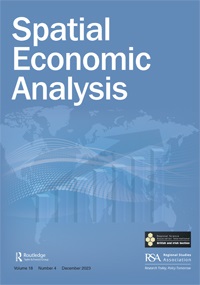SPATIAL ECONOMIC ANALYSIS
Número:
3
Publicado:
Clasificación JEL:
J61

Lo más reciente
Leonardo Fabio Morales, Leonardo Bonilla-Mejía, Didier Hermida-Giraldo, Francisco Javier Lasso-Valderrama, José Pulido
Constanza Martínez-Ventura, Ligia Alba Melo-Becerra
Leonardo Fabio Morales, Juan Chaparro-Cardona, Eleonora Dávalos, Nataly Corredor-Martinez
One explanation for the increasing number of hectares of coca is that eradication strategies displace coca crops but fail to completely clear affected areas. In the drug policy literature, that dynamic shifting is commonly known as the balloon effect. This study integrates georeferenced agricultural data through spatially explicit econometric models to test the hypothesis that forced eradication displaces coca crops. Using annual data for 1116 contiguous municipalities in Colombia, we estimate a spatial Durbin error model. Our results suggest that, on average, aerial fumigation in a municipality diffuses the benefits of this crime control strategy to neighbouring municipalities.
